What is Privacy Dashboard on Android 12? Why can it be considered a 'breakthrough' in terms of privacy?
Security and privacy are increasingly becoming major concerns for smartphone users in general. Apple is one of the pioneering manufacturers in launching larger, more optimal security features on its devices. Apple's move has received very positive feedback from the user community, and this makes another big name, Google, of course not able to ignore it.
What is Privacy Dashboard?
Privacy Dashboard is a privacy feature introduced by Google for Android 12. Through the Privacy Dashboard, users can clearly see which apps are accessing their data, as well as choose which information applications are allowed to access.
In addition, the Privacy Dashboard also provides real-time information about access activity related to various types of personal data on the device. Users can monitor private data access on the device for 24 hours, and decide if they need to modify permissions for specific apps. Not only third-party apps, even Google apps will be fully listed.
How does Privacy Dashboard work?
As the name suggests, Privacy Dashboard is basically a dashboard, allowing users to manage everything privacy related on their Android device. The Privacy Dashboard page will show which apps are using which permissions, and how often they are used.
When accessing the Privacy Dashboard in the Settings menu, you will see a management page open with two different sections. The first is the pie chart at the top of the screen. This graph allows you to quickly get a sense of what privacy has been used the most by apps on your device in the last 24 hours.

For example, in the example you can see that the 'Location' access is used the most, followed by 'Camera' and 'Micro'. This graph correlates with the list of permissions in the section below, so if you expand to 'See Other Permissions', those permissions will also appear in the chart.
Here are all the permissions that can be tracked in the Privacy Dashboard:
- Location
- Camera
- Micro
- Sensor
- Calendar
- call logs
- Phonebook
- Files and Media
- Nearby devices
- Phone
- Physical activity
- SMS messages
Below the chart are permissions in the form of a list. Each permission is labeled with how many apps have used it in the last 24 hours. Click on a specific permission to see detailed usage progress over that 24-hour period.
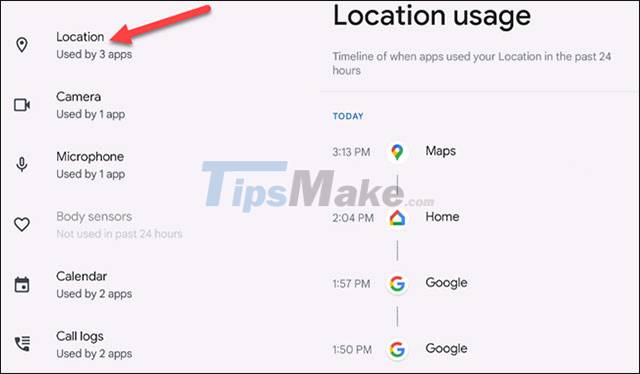
The 'Manage Permission' button will take you to a menu where you can adjust how specific apps use permissions on the device.
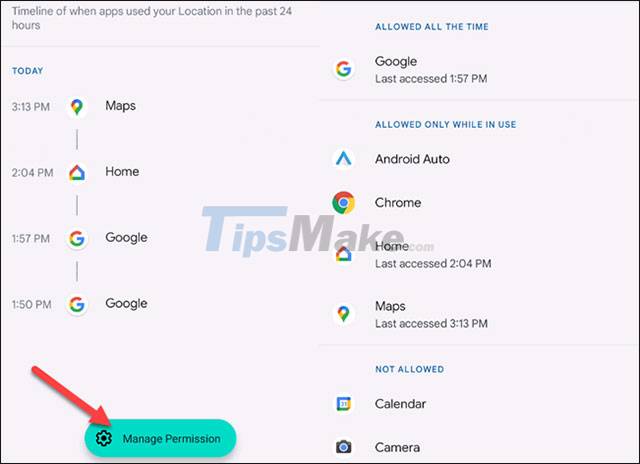
Where to find Privacy Dashboard on Android?
As mentioned above, Privacy Dashboard was introduced in Android 12. You will need a phone or tablet running Android 12 or higher to be able to use this feature.
First, swipe down from the top edge of the screen to bring up the quick settings menu, then tap the gear icon.
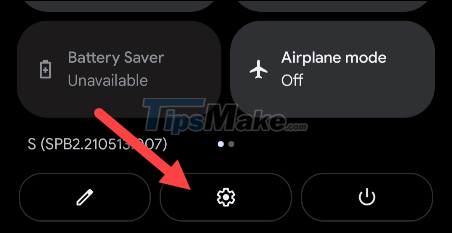
In the Settings menu, scroll down to the ' Privacy ' section
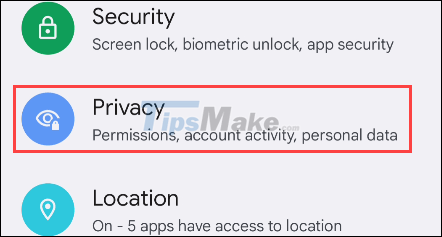
Find the ' Privacy Dashboard ' entry and click on it.
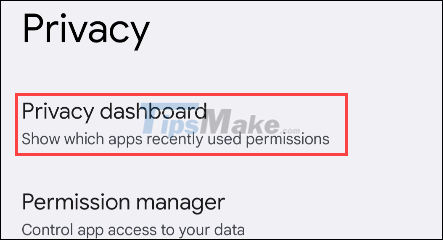
You should read it
- Privacy is Apple's most advanced product
- 5 extensions to help protect your privacy while surfing the web on Firefox
- How to use NEV Privacy - Hide Pictures hide photos, apps on Android
- Privacy practices on Google Chrome
- What is 'Privacy Sandbox' in Google Chrome? How to use?
- Google Dashboard - Everything Google knows about you
- Manage new Facebook privacy options
- Instructions for creating Dashboard on Excel
May be interested
- Important Android Privacy Settings That Are Often Overlooked
 android comes with a lot of security features, but many of them are hidden deep in settings, so they often go unused.
android comes with a lot of security features, but many of them are hidden deep in settings, so they often go unused. - Android device owners need to delete SafetyCore app now to protect privacy
 android devices have a new system app called safetycore that is causing some serious privacy issues.
android devices have a new system app called safetycore that is causing some serious privacy issues. - Discover 44 trackers on more than 300 Android apps
 recently, two teams investigating yale privacy lab and exodus privacy have teamed up to clarify the case that dozens of trackers are embedded in android applications and record user activity.
recently, two teams investigating yale privacy lab and exodus privacy have teamed up to clarify the case that dozens of trackers are embedded in android applications and record user activity. - 10 Android Apps You Should Delete Immediately to Protect Your Privacy
 your favorite apps don't just collect information for their own use; they also share it with third parties, all for profit.
your favorite apps don't just collect information for their own use; they also share it with third parties, all for profit. - Google's new Dashboard makes it easy to find collected Google information from users
 google makes it easy for you to find out what information the company knows about you thanks to a new update on the control panel of activities related to google.
google makes it easy for you to find out what information the company knows about you thanks to a new update on the control panel of activities related to google. - How to Create a Sticky Note on a Mac's Dashboard
 sticky notes are an often-overlooked feature on mac computers. you can use sticky notes to help remind you of something important or save a piece of text for quick reference. if you use the dashboard feature often, you can add sticky note...
sticky notes are an often-overlooked feature on mac computers. you can use sticky notes to help remind you of something important or save a piece of text for quick reference. if you use the dashboard feature often, you can add sticky note... - List of phones eligible for Android 12 Beta upgrade from today
 google has officially launched android 12 with a major overhaul of the interface, improved smoothness and privacy. what android users look forward to the most right now is to update the new operating system experience.
google has officially launched android 12 with a major overhaul of the interface, improved smoothness and privacy. what android users look forward to the most right now is to update the new operating system experience. - Manage new Facebook privacy options
 to address future privacy issues, facebook has launched the 'facebook and privacy' page, which will regularly upgrade changes to privacy options.
to address future privacy issues, facebook has launched the 'facebook and privacy' page, which will regularly upgrade changes to privacy options. - Google Maps adds a series of notable new security options
 with the default settings frame, google maps can really be considered a 'nightmare' for those worried about privacy.
with the default settings frame, google maps can really be considered a 'nightmare' for those worried about privacy. - More than 22,000 users unknowingly agreed to clean the toilet because they did not read the terms of the service provider
 more than 22,000 users accidentally agreed to clean the public when they connected to free wifi hotspots in the uk.
more than 22,000 users accidentally agreed to clean the public when they connected to free wifi hotspots in the uk.









 Apple releases update for iPhone 6 and below
Apple releases update for iPhone 6 and below Should iPhone 6s and iPhone 6s Plus users upgrade to iOS 15?
Should iPhone 6s and iPhone 6s Plus users upgrade to iOS 15? Steps to check genuine iPhone battery
Steps to check genuine iPhone battery How to hide the AirPlay media playback control key cluster on the iPhone's lock screen
How to hide the AirPlay media playback control key cluster on the iPhone's lock screen iOS 15 can find your iPhone even when it's powered off or factory reset by thieves
iOS 15 can find your iPhone even when it's powered off or factory reset by thieves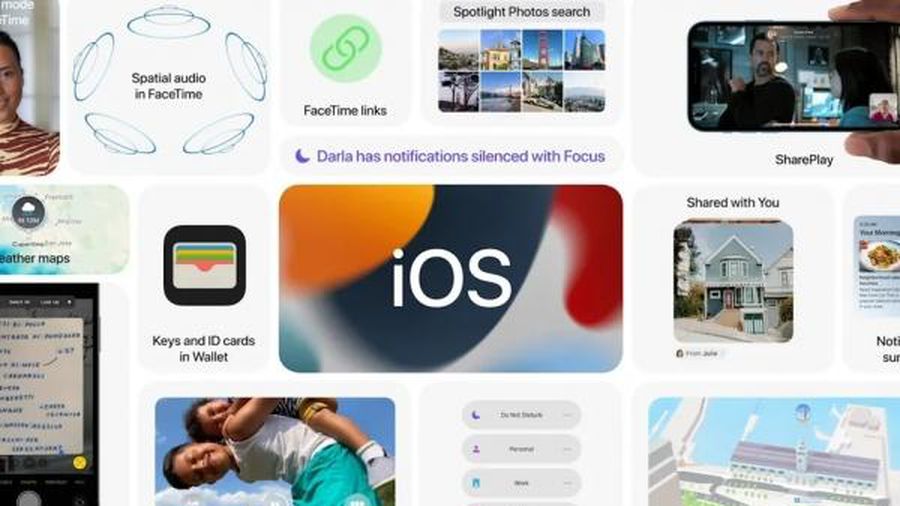 Apple officially launched iOS 15 operating system
Apple officially launched iOS 15 operating system